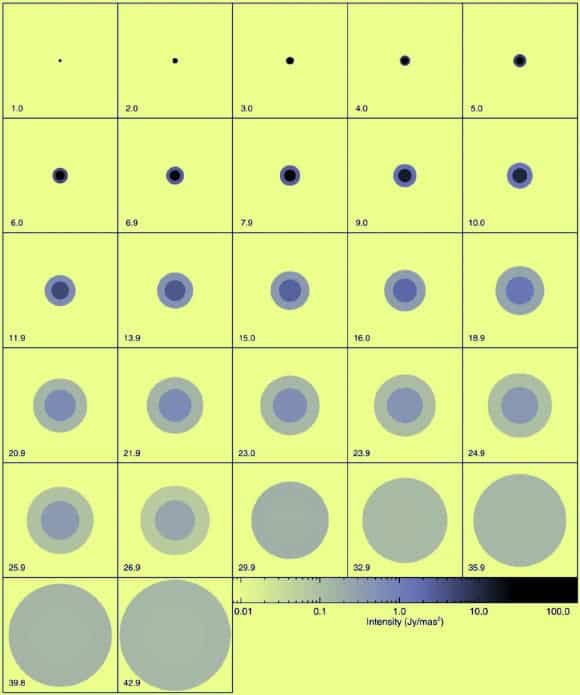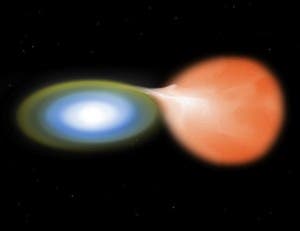Here’s something you don’t see everyday – for the first time, astronomers witnessed how a nova is formed right from the onset, capturing and detailing its expansion. The white dwarf turned nova is located some 14,800 light-years away and its study is set to reveal many things about how novas form.
The star is dead, long live the nova!

Stars shine due to the nuclear fusion reactions in their cores, which process hydrogen into helium, releasing energy in the process. When the hydrogen is used up, sun-like stars slough off their outer envelopes, and become very small, very hot “white dwarfs.” These white dwarfs are basically the core that remains of a star after it had used up all its available hydrogen. Now, stars often come in pairs – these are called binary systems. More often than not, when a white dwarf is gravitational tugged with a larger neighbor, say a red giant (a star that’s at the end of its life, but at a stage before shrinking into a white dwarf), the dwarf will act as a vampire and suck hydrogen from its compannion. The white dwarf thus starts accumulating a rising “ocean” of hydrogen on its surface. Once the hydrogen ocean become deep enough, the rising pressure will hit a critical level that will cause the dwarf’s surface to expand in an explosion similar to a thermonuclear bomb. The white dwarf is now reborn, hence the name – “nova” comes from the latin “new star”.
[RELATED] The most powerful stars are actually vampire binary systems
Novas should not be confused with their more spectacular brethren, supernovas. Supernovas are among the most powerful and spectacular events in the universe, and aren’t very common. They represent a dramatic culmination of a star’s life, after all of its nuclear fuel is spent and the outward pressure is no longer able to counteract the gravity. This causes the star to suddenly collapse so fast that it makes enormous shock waves that blow the outer part of the star into space at 20,000 kilometers per second (50 million miles per hour)! Needless to say, supernovas can only happen once, but a dying star can sometimes explode in novas more than once. It’s a key difference.
A stroke of luck

No one was able to witness a nova from its very onset, until Aug. 14, 2013, when Japanese amateur astronomer Koichi Itagaki detected an object that was dubbed Nova Delphinus 2013. Itagaki was the man of the moment – he was looking at the right patch of the sky at the very right moment and was able to see and capture the nova that had just flashed into existence hours before. Shortly after Itagaki’s discovery, scientists at the Mt. Wilson Observatory in the Angeles National Forest were notified and immediately turned their scope on the nova which they studied for the following weeks. Using the Center for High Angular Resolution Astronomy array, which consists of six 1-meter telescopes, immense volumes of data were gathered that allowed the astronomers to reconstruct the first three nights following the nova’s birth. In total, the nova expansion was followed for 27 nights over two months.
Here’s how it progressed:
- In its first day the nova was the size of Earth’s orbit;
- Two days later it was the size of Mars’ orbit;
- Only two week later it was the size of Jupiter’s orbit
- Day 43 and Nova Delphinus was as large as Neptune’s orbit – the most distant planet in our solar system (sorry, Pluto!) – or a x20 increase from its initial size.

Peculiar as it may seem, the Nova’s surface isn’t spherical, being 13% longer than wide. There’s a perfectly reasonable explanation: it means the nova didn’t expand uniformly and reactions differ across the entire surface. On previously studied, older novas this asymmetry was pinned to dust and debris as they expand over long stretches of time. Since Nova Delphinus is asymmetric from birth, something else is at play.
“The fact that we see it two days after shows that the explosion itself is not symmetric – which gives you clues about how material is being ejected from the surface of the white dwarf,”said lead author Gail Schaefer, an astronomer at Georgia State University.

Nova Delphinus might once again erupt in a spectacle of light, but it’s highly unlikely this will happen during our lifetimes. The nova was described in a paper published Nature.
Dr Theo ten Brummelaar of Georgia State University stated that, “The recent information enable us to study in detail exactly how the fireball evolves as the gas expands and cools. It seems like the ride is a lot more complex and jarring for the gas than the simple models used previously would have predicted.”
Scientific reference: G. H. Schaefer et al. The expanding fireball of Nova Delphini 2013. Nature, published online October 26, 2014; doi: 10.1038/nature13834


